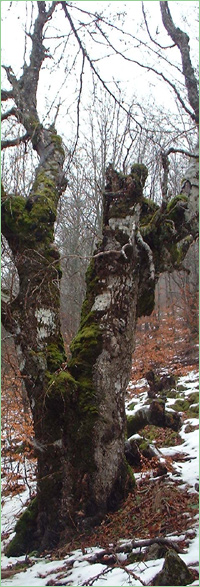Ribarnitsi Mechka (Unique identification code in the register: BG0002024)
Category: PZ under the Bird Directive
Area: 2582.34 hectares Location:
1.
District: Ruse, Municipality: Borovo, Locality: Batin, Gorno Аblanovo
2.
District: Ruse, Municipality: Ivanovo, Locality: Mechka
Falls in the territory of the following Regional Inspectorates of Environment and Water (RIEW):
Ruse - bul."Pridunavski" 20 p.k.26
Ordinance for announcement:
Ordinance No.РД-561 from 05.09.2008
2-1-2024-561-2008
Ordinance for change:
Define a specific aims with Ordinance No.РД-1041 from 03.11.2022
Record for protected zone (link):

Aims of the declaration:
1. Protection and maintenance of the habitats of the birds under item 2 to reach their favorable conservation status
2. Restoration of the habitats of the birds under item 2, which is necessary to reach their improve the favorable conservation condition
Objects of protection (species or habitats):
1. Article 6, paragraph 1, section 3 from Biological Diversity Act: Pygmy Cormorant (Phalacrocorax pygmeus), Dalmatian Pelican(Pelecanus crispus), Bittern (Botaurus stellaris), Little Bittern (Ixobrychus minutus), Night Heron (Nycticorax nycticorax), Squacco Heron (Ardeola ralloides), Little Egret (Egretta garzetta),Great White Egret (Egretta alba), Purple Heron(Ardea purpurea), Black Stork (Ciconia nigra), White Stork (Ciconia ciconia), Glossy Ibis (Plegadis falcinellus), Eurasian Spoonbill (Platalea leucorodia), Whooper Swan (Cygnus cygnus), Lesser White-fronted Goose (Anser erythropus), Red-breasted Goose (Branta ruficollis), Ruddy Shelduck (Tadorna ferruginea), Ferruginous Duck (Aythya nyroca), Smew (Mergus albellus), Levant sparrowhawk (Accipiter brevipes), Honey Buzzard (Pernis apivorus), Black Kite (Milvus migrans), Long-legged Buzzard (Buteo rufinus), White-tailed Eagle (Haliaeetus albicilla), Short-toed Eagle(Circaetus gallicus), Marsh Harrier (Circus aeruginosus), Hen Harrier (Circus cyaneus), Pallid Harrier (Circus macrourus), Lesser Spotted Eagle (Aquila pomarina), Greater spotted eagle (Aquila clanga), Golden Eagle (Aquila chrysaetos), Imperial Eagle(Aquila heliaca), Booted Eagle (Hieraaetus pennatus), Osprey (Pandion haliaetus), Red-footed Falcon (Falco vespertinus), Merlin(Falco columbarius), Spotted Crake (Porzana porzana), Baillon's Crake (Porzana pusilla), Corncrake (Crex crex), Common Crane (Grus grus), Common Stilt (Himantopus himantopus), Pied Avocet (Recurvirostra avosetta), Ruff (Philomachus pugnax), Wood Sandpiper (Tringa glareola), Little Gull (Larus minutus), Caspian Tern(Sterna caspia), Common Tern (Sterna hirundo), Little Tern (Sterna albifrons), Whiskered Tern (Chlidonias hybridus), Black Tern (Chlidonias niger), Eurasian Eagle-owl (Bubo bubo), Common Kingfisher (Alcedo atthis), European Roller (Coracias garrulus), Black Woodpecker (Dryocopus martius), Syrian woodpecker (Dendrocopos syriacus), Aquatic Warbler (Acrocephalus paludicola), Red-backed Shrike (Lanius collurio), Lesser Grey Shrike (Lanius minor), Ortolan Bunting (Emberiza hortulana);
2. Article 6, paragraph 1, section 4 from Biological Diversity Act: Little Grebe (Tachybaptus ruficollis), Great Crested Grebe(Podiceps cristatus), Red-necked Grebe (Podiceps grisegena), Black-necked Grebe (Podiceps nigricollis), Great Cormorant (Phalacrocorax carbo), Grey Heron (Ardea cinerea), Mute Swan (Cygnus olor), Bean Goose (Anser fabalis), Greater White-fronted Goose (Anser albifrons), Greylag goose (Anser anser), Common Shelduck(Tadorna tadorna), Wigeon (Anas penelope), Gadwall (Anas strepera), Wild duck (Anas platyrhynchos), Northern Pintail (Anas acuta), Garganey (Anas querquedula), Northern Shoveler (Anas clypeata), Common Pochard (Aythya ferina), Tufted duck (Aythya fuligula), Greater Scaup (Aythya marila), Velvet Scoter (Melanitta fusca), Common Goldeneye(Bucephala clangula), Red-breasted Merganser (Mergus serrator), Common Merganser (Mergus merganser), Eurasian sparrowhawk (Accipiter nisus), Common Buzzard(Buteo buteo), Common Kestrel (Falco tinnunculus), Eurasian Hobby (Falco subbuteo), Common Moorhen (Gallinula chloropus), Eurasian Coot(Fulica atra), Eurasian Oystercatcher (Haematopus ostralegus), Little Ringed Plover(Charadrius dubius), Grey Plover (Pluvialis squatarola), Northern Lapwing (Vanellus vanellus), Сив брегобегач (Calidris temminkii), Curlew Sandpiper (Calidris ferruginea), Dunlin(Calidris alpina), Jack Snipe(Lymnocryptes minimus), Common Snipe (Gallinago gallinago), Black-tailed Godwit (Limosa limosa), Eurasian Curlew(Numenius arquata), Spotted Redshank (Tringa erythropus), Common Redshank (Tringa totanus), Marsh Sandpiper (Tringa stagnatilis), Greenshank (Tringa nebularia), Green Sandpiper (Tringa ochropus), Ruddy Turnstone (Arenaria interpres), Black-headed Gull (Larus ridibundus), Common Gull (Larus canus), White-winged Tern (Chlidonias leucopterus), European Bee-eater (Merops apiaster), Bank Swallow (Riparia riparia), Yellow-legged Gull (Larus cachinnans).
Current prohibitions and regimes:
1. It is prohibited the construction of new ports, terminals and industrial enterprises;
2. It is prohibited the destruction of island formations;
3. It is prohibited afforestation of meadows, pastures and grassland, as well as to transform it in area under cultivation and permanent crops;
4. It is prohibited to remove landscape features (hedges, single trees and groups) in the use of agricultural land ;
5. It is prohibited to carry out overdrying activities or modifying the hydrological system, except while carring out activities to improve the status of the water ecosystems and habitats;
6. It is prohibited felling which lead to decrease or substitute the species;
7. It is prohibited to carry out felling in range of 300 m. around the nests of raptors and around nesting colonies of herons and cormorants during the nesting season (March 1 to July 31);
8. It is prohibited setting on fire cane massif and coastal vegetation;
9. It is prohibited mowing of of cane, rush and floating aquatic vegetation in canals and basins, along the banks and dikes in the period 1 March to 15 August.
Overlapping (partial or full):
1.
Natural Monument: Dikili Tash
2.
Protected Site: Doychov Ostrov
3.
Protected Site: Stalpishte

|
|

|


 Превод на български
Превод на български